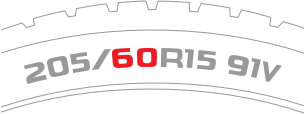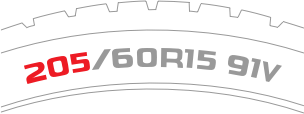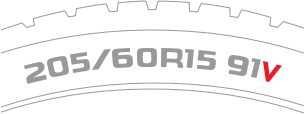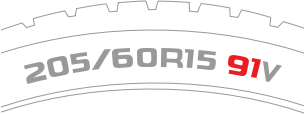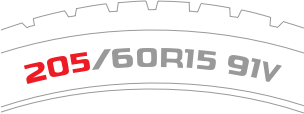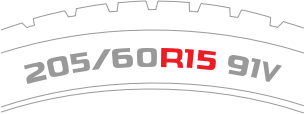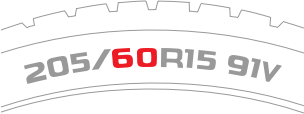Calculate Tyre Size
Tyre size chart
Have you ever wondered what the markings on the sidewall of your tyre mean? Your tyre’s sidewall markings are a tyre specification guide containing important information about size, load, and much more. This indicates the nominated tyre size for your vehicle from the manufacturer. Be careful if changing away from the nominated tyre size, as this could make your vehicle un-roadworthy.
Learn how to read tyre codes and your tyre size with the tyre size calculator.
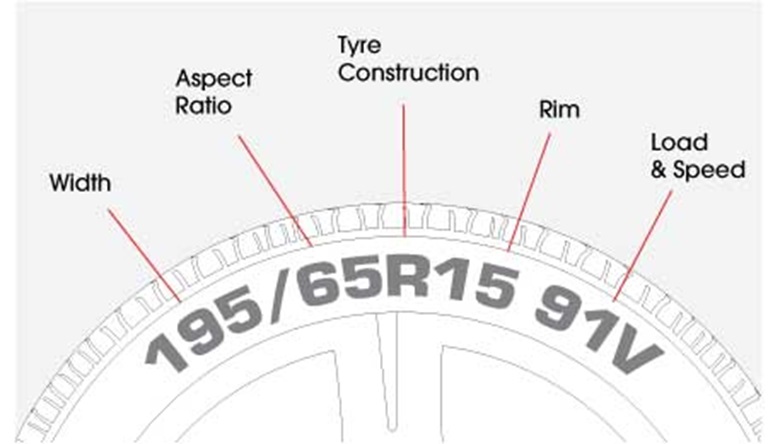
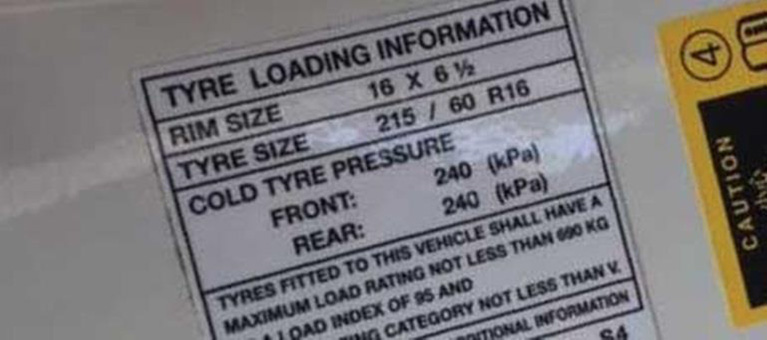
Vehicle placard tyre size
Vehicle manufacturers will always provide tyre size information in the car user manual and also via a tyre placard fitted to your car. This will include information about the recommended tyre sizes, wheels and the correct tyre inflation pressure depending on vehicle use. The tyre placard is generally found inside the driver’s door opening, but sometimes found inside the fuel cap, glove box or under the bonnet. It is generally possible to fit aftermarket wheels and tyres of a different size, but it is important to consult a tyre professional before doing so to ensure the wheels and tyres meet local road regulations. A different inflation pressure may be needed in this case also.
Tyre size explained
Tyre dimensions
Width:
The section width of your tyre in millimetres, from the inner sidewall to the outer sidewall. Example: 195mm
Aspect Ratio:
The height of your tyre from the base of the tread to the rim, as a percentage of the tread width. Low profile tyres have smaller aspect ratios. Example: The height of this tyre is 65% of its width.
Tyre Construction:
The method used to construct your tyre. Example: R, for radial ply construction. This is the most common method of construction for passenger tyres.
Rim:
The diameter of the wheel rim in inches. If you are buying wheels for existing tyres, this is the size you will need. Example: 15 inches.
Load Index and Speed Symbol
The maximum load capacity under which your tyre can safely operate, and at what speed. This is subject to the tyre being in sound condition, correctly fitted, and with the recommended inflation pressure. Example: 91 V
How to find your tyre size?
Knowing how to check tyre size is straightforward. You can find your tyre size by examining the sidewall of the tyre, referencing your vehicle's owner's manual, or locating the placard inside the driver’s door jamb. Accurate tyre size ensures optimal performance, safety, and fuel efficiency.
If still uncertain about your tyre size, contact your local Bridgestone store who will be able to assist with all your tyre needs.
Read your tyre size
-
How to check your tyre size
-
Width
-
Profile
-
Rim
-
Load
-
Speed
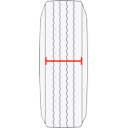 Indicates the section width of a tyre in millimetres.
Indicates the section width of a tyre in millimetres.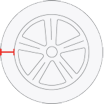 The sidewall height measured from the base of the tread to the rim. This number represents a percentage of the tread width. Low profile tyres have smaller aspect ratio percentages.
The sidewall height measured from the base of the tread to the rim. This number represents a percentage of the tread width. Low profile tyres have smaller aspect ratio percentages.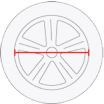 Indicates the diameter of the wheel rim. So if you are buying wheels for existing tyres, this is the size in inches you will require.Load indicates the maximum load capacity at which a tyre can be safely operated, subject to the tyre being in sound condition, correctly fitted and with the recommended inflation pressure. See table below for load index and the maximum load per tyre.
Indicates the diameter of the wheel rim. So if you are buying wheels for existing tyres, this is the size in inches you will require.Load indicates the maximum load capacity at which a tyre can be safely operated, subject to the tyre being in sound condition, correctly fitted and with the recommended inflation pressure. See table below for load index and the maximum load per tyre.
Load index 83 84 85 86 87 88 89 90 91 92 93 94 95 96 97 98 99 Max load/tyre (kg) 487 500 515 530 545 560 580 600 615 630 650 670 690 710 730 750 775 Speed symbol is a code which indicates the speed at which a tyre can be safely operated, subject to the tyre being in sound condition, correctly fitted and with the recommended inflation pressure. See table below for passenger tyre speed symbol ratings.
Symbol E F G J K L M N P Q R S T U H V W Y Z Rating 70 80 90 100 110 120 130 140 150 160 170 180 190 200 210 240 270 300 240+ -
Tyre speed rating chart
Tyre speed symbol table
Speed symbol is a code which indicates the speed at which a tyre can be safely operated, subject to the tyre being in sound condition, correctly fitted and with the recommended inflation pressure. See table below for passenger tyre speed symbol ratings.
| Speed Symbol | Rating (Km/h) |
| E | 70 |
| F | 80 |
| G | 90 |
| J | 100 |
| K | 110 |
| L | 120 |
| M | 130 |
| N | 140 |
| P | 150 |
| Q | 160 |
| R | 170 |
| S | 180 |
| T | 190 |
| U | 200 |
| H | 210 |
| V | 240 |
| W | 270 |
| Y | 300 |
| Z | 240+ |
Tyre load rating chart
Tyre load index table
Load indicates the maximum load capacity at which a tyre can be safely operated, subject to the tyre being in sound condition, correctly fitted and with the recommended inflation pressure. See table below for load index and the maximum load per tyre.
|
Load Index |
Max Load (kg) |
Load Index |
Max Load (kg) |
Load Index |
Max Load (kg) |
Load Index |
Max Load (kg) |
Load Index |
Max Load (kg) |
Load Index |
Max Load (kg) |
|---|---|---|---|---|---|---|---|---|---|---|---|
| 60 | 250 | 85 | 515 | 110 | 1060 | 135 | 2180 | 160 | 4500 | 185 | 9250 |
| 61 | 257 | 86 | 530 | 111 | 1090 | 136 | 2240 | 161 | 4625 | 186 | 9500 |
| 62 | 265 | 87 | 545 | 112 | 1120 | 137 | 2300 | 162 | 4750 | 187 | 9750 |
| 63 | 272 | 88 | 560 | 113 | 1150 | 138 | 2360 | 163 | 4875 | 188 | 10000 |
| 64 | 280 | 89 | 580 | 114 | 1180 | 139 | 2430 | 164 | 5000 | 189 | 10300 |
| 65 | 290 | 90 | 600 | 115 | 1215 | 140 | 2500 | 165 | 5150 | 190 | 10600 |
| 66 | 300 | 91 | 615 | 116 | 1250 | 141 | 2575 | 166 | 5300 | 191 | 10900 |
| 67 | 307 | 92 | 630 | 117 | 1285 | 142 | 2650 | 167 | 5450 | 192 | 11200 |
| 68 | 315 | 93 | 650 | 118 | 1320 | 143 | 2725 | 168 | 5600 | 193 | 11500 |
| 69 | 325 | 94 | 670 | 119 | 1360 | 144 | 2800 | 169 | 5800 | 194 | 11800 |
| 70 | 335 | 95 | 690 | 120 | 1400 | 145 | 2900 | 170 | 6000 | 195 | 12150 |
| 71 | 345 | 96 | 710 | 121 | 1450 | 146 | 3000 | 171 | 6150 | 196 | 12500 |
| 72 | 355 | 97 | 730 | 122 | 1500 | 147 | 3075 | 172 | 6300 | 197 | 12850 |
| 73 | 365 | 98 | 750 | 123 | 1550 | 148 | 3150 | 173 | 6500 | 198 | 13200 |
| 74 | 375 | 99 | 775 | 124 | 1600 | 149 | 3250 | 174 | 6700 | 199 | 13600 |
| 75 | 387 | 100 | 800 | 125 | 1650 | 150 | 3350 | 175 | 6900 | 200 | 14000 |
| 76 | 400 | 101 | 825 | 126 | 1700 | 151 | 3450 | 176 | 7100 | 201 | 14500 |
| 77 | 412 | 102 | 850 | 127 | 1750 | 152 | 3550 | 177 | 7300 | 202 | 15000 |
| 79 | 437 | 104 | 900 | 129 | 1850 | 154 | 3750 | 179 | 7750 | 204 | 16000 |
| 80 | 450 | 105 | 925 | 130 | 1900 | 155 | 3875 | 180 | 8000 | 205 | 16500 |
| 81 | 462 | 106 | 950 | 131 | 1950 | 156 | 4000 | 181 | 8250 | 206 | 17000 |
| 82 | 475 | 107 | 975 | 132 | 2000 | 157 | 4125 | 182 | 8500 | 207 | 17500 |
| 83 | 487 | 108 | 1000 | 133 | 2060 | 158 | 4250 | 183 | 8750 | 208 | 18000 |
| 84 | 500 | 109 | 1030 | 134 | 2120 | 159 | 4375 | 184 | 9000 | 209 | 18500 |
OD:
The overall diameter of your unloaded tyre in mm.
Type Definitions:
An abbreviation providing information about the type of your tyre.
Examples:
RFT – Run Flat Technology
MOE – Mercedes Original Equipment
LRR – Low Rolling Resistance
RBT – Raised Black Letters Tubeless
OWT – Outline White Letters Tubeless
RWT – Raised White Letters Tubeless
LWT – Line White Tubeless
TT – Tube Type
TL – Tubeless
XL – Extra Load
LT – Light Truck construction
N* - Porsche specification
☆ – BMW spec
Let's find tyres to suit you
Frequently asked questions
-
Can I change my tyre size from the manufacturer’s recommendation?
Changing tyre size can affect your car’s handling, braking, and safety systems. It may also impact your roadworthiness and insurance coverage. If you are considering a different size, consult a qualified tyre professional and ensure any replacement tyres meet Australian safety standards and your vehicle’s specifications.
-
Why is it important to follow the recommended tyre size?
Using the correct tyre size helps maintain vehicle stability, fuel efficiency, and braking performance. It also ensures your tyres wear evenly and that safety systems, such as ABS and traction control, function correctly. Following the manufacturer’s recommendation keeps your car performing safely under typical Australian driving conditions.
-
What tyre size should I choose for my car?
We recommend using the tyre size specified by your vehicle manufacturer on the tyre placard, usually located inside the driver’s door, glove box, or fuel flap. Using a different tyre size may affect your car’s handling, safety, and roadworthiness, and could impact insurance coverage.
-
How do you determine which tyres fit my vehicle?
We match tyres based on your car’s original manufacturer-recommended size. Using our online tyre size calculator, make sure to enter your vehicle’s make, model, and year accurately. You can also search for compatible tyres using your registration number or by entering the tyre size from your current tyres.
This ensures any replacement tyres meet safety and performance standards in Australia.
-
What do the tyre numbers mean?
The tyre sidewall, located between the wheel rim and tread, displays tyre numbers and letters that indicate the tyre’s size, construction, load capacity, and speed rating. These markings help you select tyres that fit your car safely and perform reliably.
For example, a tyre marked 205/55 R16 91V means:
- 205 = tyre width in millimetres
- 55 = aspect ratio (sidewall height as a percentage of width)
- R16 = radial construction and wheel diameter in inches
- 91V = load index and speed rating
Always check your vehicle’s tyre placard or owner’s manual, and use the Bridgestone tyre size calculator to confirm compatibility and ensure optimal performance.
-
Width
-
Aspect
-
Rim Size
-
Load
-
Speed
The section width of your tyre in millimetres.The sidewall height measured from the base of the tread to the rim. This number represents a percentage of the tread width. Low profile tyres have smaller aspect ratio percentages.The diameter of the wheel rim in inches. This is the size you will need to choose if you are buying wheels for an existing tyre.The maximum load capacity at which your tyre can be safely operated. This is subject to your tyre being in sound condition, correctly fitted and inflated at the recommended pressure.A code indicating the speed at which your tyre can be safely operated. Again, this is subject to your tyre being in sound condition, correctly fitted and inflated at the recommended pressure.

